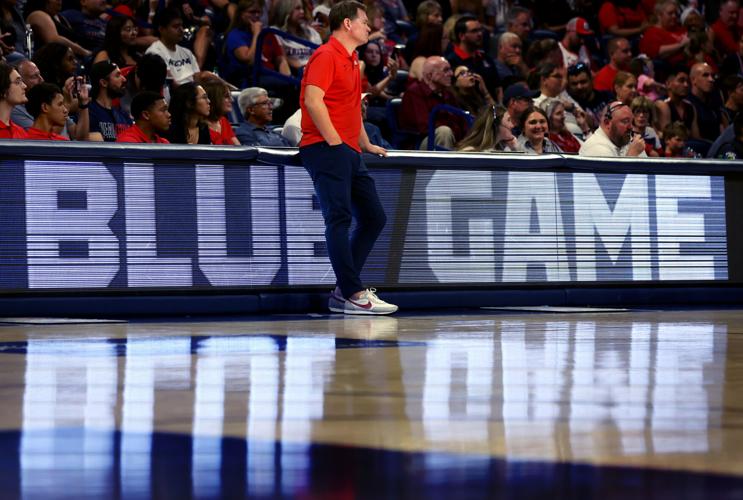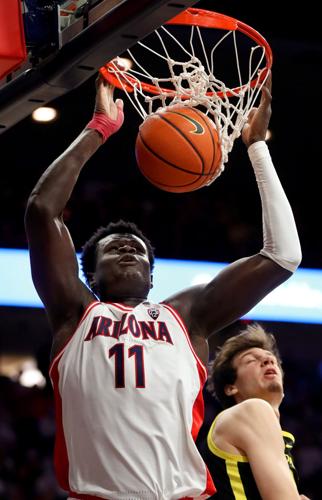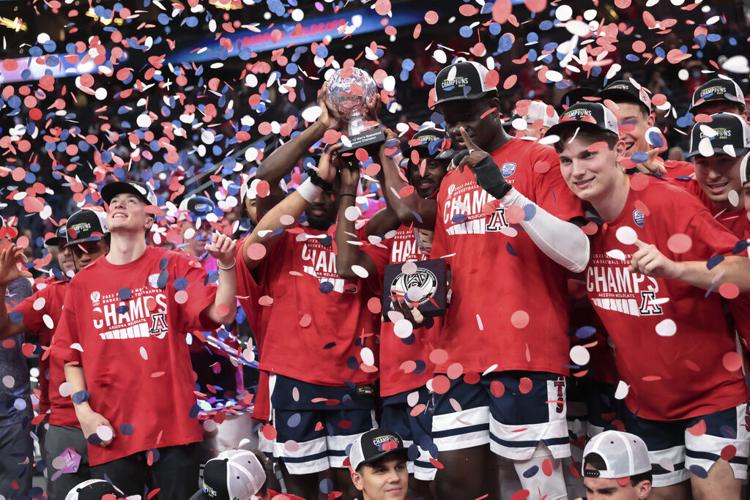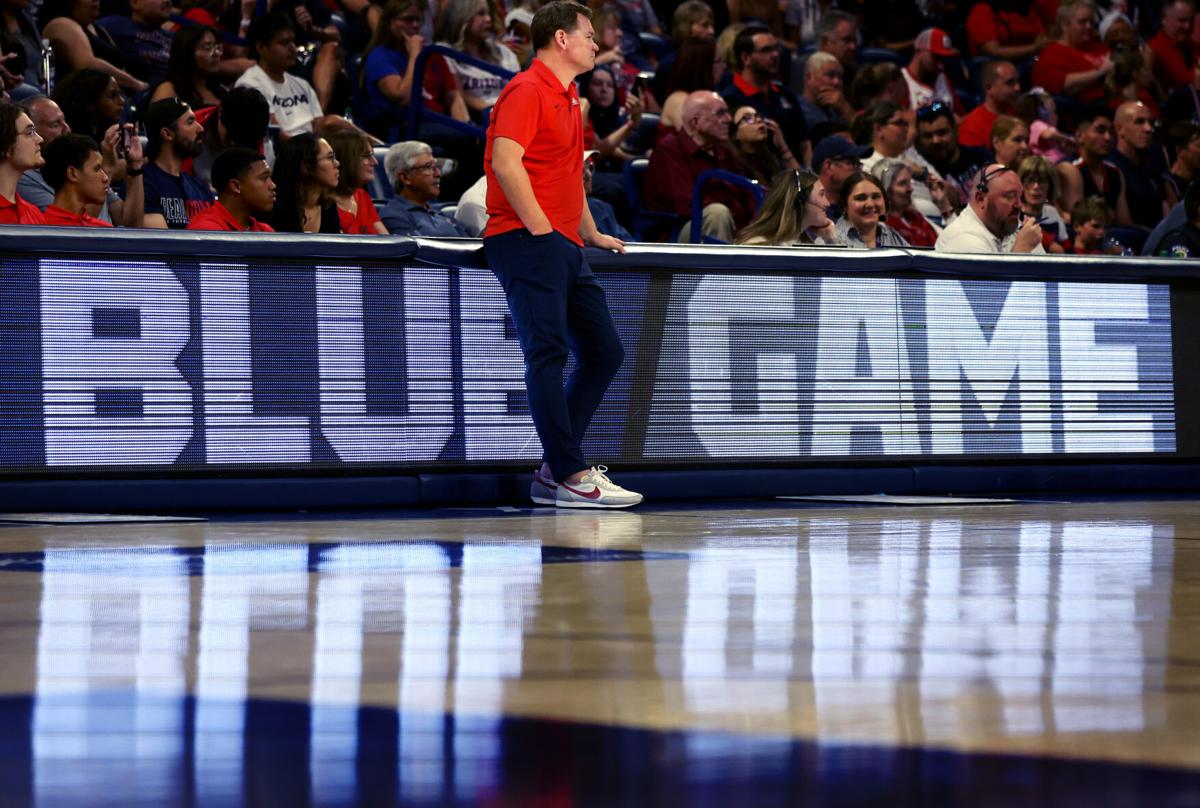Because college basketball teams can schedule two extra games each season they play in multi-team events, what are casually known as “MTEs” have spilled out all over the college basketball landscape and beyond, even to far-flung Caribbean and Hawaiian islands.
But teams are allowed to play in the same MTE only once every four years, and there’s still really only two prestigious ones: The Maui Invitational and the Bahamas’ Battle 4 Atlantis, while the NIT Season Tip-Off in New York also carries some historical cred.
That created a problem this season for Tommy Lloyd and the Arizona basketball program, which played in Maui last season, is scheduled to play in the Battle 4 Atlantis next season ... and is ranked No. 12 in the Associated Press preseason Top 25.
The Wildcats wanted a challenge. But initially this season, they were scheduled to play in the Wooden Legacy, a Thanksgiving weekend MTE that was lightly attended in Southern California’s Orange County and is now moving to Las Vegas; but the event initially had only UA and BYU committed, with no promise of other high-level programs.
So Arizona backed out, promising the event sponsor it would play in a future event the company promoted. Then, the Wildcats created their own “MTE” of sorts.

Arizona guard Pelle Larsson (3) gets high fives from the crowd after the Wildcats held on down the stretch for a 58-52 win against UCLA at McKale Center in January.
Call it the ‘Tommy Lloyd Invitational’
“We weren’t playing in a Maui-type MTE this year, so I felt like we kind of needed to play a lot of high-level games,” says TJ Benson, who handles scheduling as UA’s special assistant. “To do that, we kind of had to get creative.”
They did. While UA is technically playing in an official MTE — games against Michigan State and Texas-Arlington make up something known as the “Acrisure Classic” — the Michigan State game is also one of four neutral-site games the Wildcats are stringing together — its own sort of makeshift “event.” Arizona will also face Purdue in Indianapolis, Alabama in Phoenix and Florida Atlantic in Las Vegas during the nonconference season.
Call it the Tommy Lloyd Invitational, or something like that.
“Doesn’t really matter because “It’s just good games, you know?” UA center Oumar Ballo said. “It is every game is challenging, and we love to be challenged.”
Along with two nonconference games that will appear as part of old-school home-and-home series — at Duke on Nov. 10 and against Wisconsin on Dec. 9 at McKale Center — the Wildcats will play a total of six nonconference games against the top 26 vote-getters in the preseason poll. Those six games will pair with five one-time guarantee games against mid- or low-major opponents to complete what could ultimately become one of UA’s strongest-ever nonconference schedules.
Together, the neutral-site games should give the Wildcats the sort of varied and difficult opponents they are aiming to sharpen themselves against before Pac-12 play begins after Christmas.
First, Arizona will face Michigan State in a Thanksgiving Day game in the Palm Springs area. That will give the Wildcats a chance to test themselves against a Top-5 opponent that features one of the country’s slowest paces and creates 3-point shots it was able to hit at a 39.3% rate last season.
On Dec. 16, the Wildcats will play Purdue in the semi-neutral site of Indianapolis’ Gainbridge Fieldhouse, getting a chance to face arguably the nation’s best team and the reigning Player of the Year in center Zach Edey. The Boilermakers also run one of the nation’s slowest paces, potentially testing the Wildcats in multiple ways.
UA’s other semi-neutral game, against Alabama at Phoenix’s Footprint Center, could be a horse race of sorts between two of the most uptempo-minded programs in college basketball.
Finally, the Wildcats will wrap up their nonconference season by facing Florida Atlantic, a veteran team that reached the Final Four last season with a top-25 offensive efficiency. They’ll do it at Las Vegas’ T-Mobile Arena, where the Wildcats are undefeated under Lloyd.
That’s four games, all at neutral sites, almost like a real MTE. It’s just that it will spread from California to Indiana to Arizona and then to Nevada, all before Christmas.
It’s the kind of present Lloyd was looking for.
“I want to go to the most prestigious ones we can be involved with, because I think that’s what Arizona basketball should be” playing in, Lloyd said. “Maui is a can’t-miss. Bahamas is another great one, but it has kind of changed. It used to be the Preseason NIT and the Great Alaska Shootout, which was awesome going up there.
“So it is a little bit of a changing landscape and there’s just so many more of them popping up. Now you get these one-game neutral deals and we’re in a lot of them. It’s a great opportunity for us.”
Lloyd started putting together the 2023-24 schedule when he and then-new Duke coach Jon Scheyer agreed in July 2022 to a home-and-home series, with UA heading to Duke this season and the Blue Devils visiting McKale Center next season.
UA later set up the Wisconsin home-and-home that will send the Wildcats to Madison next season, and the neutral games fell into place quickly after last season.
The Michigan State and Alabama games were both finalized by last spring, with Arizona hosting the Crimson Tide this season in Phoenix as part of the Dec. 20 Jerry Colangelo Hall of Fame Series. The game will be returned next season to an opposite semi-neutral site in Birmingham, Alabama.
While the Wildcats aren’t always a commercial success in Phoenix, drawing just 8,907 fans for a game against Texas A&M there in 2017-18, Lloyd says the tie-in to the Colangelo event will add to it: Both UA and ASU will have their men’s and women’s teams playing in the four-game showcase.
“For me, when we first talked about doing something up there, it was really important that we sell it out. I want it to be an event,” Lloyd said. “We felt the best way to make it an event was having Arizona State, Arizona, men’s and women’s programs, all playing a quadruple header. That’s really cool for the state of Arizona. Hopefully it sells out.”
At nearly the same time, Arizona struck another semi-neutral deal, agreeing to face Purdue in Indianapolis in exchange for a game in Las Vegas next season.
“That one kind of happened because we were trying to play a home-and-home initially,” Benson said. “We were looking at playing them maybe in the Jimmy V Classic at New York. They’re in Maui (relocated to Honolulu) this season, and they didn’t want to come to us … so we ended up settling on `Hey, let’s just do a two-year neutral-neutral series.’
“The scheduling stuff, man, it’s constantly working on things. You’re literally talking with some teams about five different options and then you might not even do it. Or you finalize one of them. There’s a lot of conversations and just takes a while for stuff to get together.”

Arizona players celebrate after defeating UCLA in the Pac-12 Tournament championship in Las Vegas in March. UA’s trip to “McKale North” for the 2024 event will be the last time it plays a conference tournament game there for a while, but the Wildcats will also be there in December, facing FAU.
Vegas: Cats’ home away from home
The Florida Atlantic possibility became particularly difficult to nail down, not only because the teams didn’t start talking until June but also because Arizona needed a final home game to satisfy its 18-game requirement for season-ticket packages and financial projections.
FAU became a hot property after reaching the Final Four last season under coach Dusty May, and it doesn’t need to play one-time “guarantee” games at other home sites. Benson said FAU was also not interested in a home-and-home that would pull the Wildcats to Boca Raton, Florida.
But Arizona also wasn’t that wild about getting a game at home on Dec. 23 anyway, since that’s when UA students aren’t in session. Last season, Arizona edged Tennessee 75-70 before a sold-out crowd at McKale on Dec. 17 but lacked the significant behind-the-basket presence of a full and rowdy student section.
So Las Vegas it was, at least giving the Wildcats a chance to play at what they call “McKale North” — T-Mobile Arena — instead of the real McKale.
Still, playing in Las Vegas meant Arizona needed a final home game. That was a tense process that bled into September until the school convinced Southern to move its scheduled Nov. 12 game from its Baton Rouge, La., campus to McKale in exchange for cash (the Star has filed a public records request for the contract) and a game in Baton Rouge in a future season.
In the end, it all worked out for the Wildcats, yet another example of how conversations among coaches — and in this case the television network, Fox — can make it happen.
Fox “wanted Dec. 23, they had a national timeslot and they wanted a prominent college basketball game,” Lloyd said. “They worked hard behind the scenes to try to make it work for us. TV is obviously a big driver of everything we do in college sports. There’s no looking around that.
“But also college basketball coaches, for the most part, have pretty good relationships with each other. So there’s a lot of those conversations that start it and then you take it to your administrators, then it gets pitched to TV and it kind of works.”
Unlike football, quick-react scheduling
Lloyd said the last-minute contract with the Owls was an example of how college basketball, unlike football, can benefit from not scheduling nonconference games out years ahead of time.
“How cool is it that we were able to figure out something with Florida Atlantic, which was a Cinderella program has everybody returning — and get a chance to play on Fox national TV on Dec. 23,” Lloyd said. “If we had to schedule this thing four or five years out, it never would have happened. We never would have that foresight.”
However, all the Wildcats’ neutral-site games meant only one of their big six nonconference opponents, Wisconsin, will actually appear at McKale.
If that’s a problem with Tucson-based fans, Lloyd says he understands why. But his Wildcats wouldn’t be home in a real MTE anyway, he noted.
“Last year, we played three neutral games in Maui,” he said. “This year we’re playing four neutral games. Three of them are regional, and one of them we’re going back to Indianapolis. It’s a little bit more spread out, so maybe it looks a little bit different. But the format maybe is not as different as you would think.”
Neutral-site games also have their advantages, allowing teams to play higher-level opponents who won’t go to their campus sites while also allowing teams to get used to the same sort of high-intensity, neutral-site experience they will face in the NCAA Tournament.
The bonus for Arizona is the variation it will see in each of its six top nonconference opponents, allowing the Wildcats to develop resiliency and find out how best to bend their playing rotation depending on the scheme it is facing.
“There are matchups you look at and how they are going to help you in the NCAA tournament,” Benson said. “Alabama’s up and down. Michigan State and Purdue are very set-oriented and will be more methodical. FAU, I think they’re going to be athletic, and they’re probably going to switch a lot — they return a lot of good players from their team from last year.
“So there’s a lot of factors. But when I was going through it with Tommy, we didn’t want to play too many teams that played slow. You want to mix it up at the end of the day.”

Arizona center Oumar Ballo (11) finishes off an alley-oop past Oregon center Nate Bittle (32) in the second half of the Wildcats’ Pac-12 matchup withe Ducks on Feb. 2 at McKale Center.
Deepest UA roster in recent memory
What is Lloyd’s deepest roster yet since he arrived at Arizona before the 2021-22 season has the ability to mix it up as needed depending on the matchup.
Fast or slow, big or small, or anything in between.
They could deploy a huge frontcourt with two 7-footers (maybe all-conference senior Oumar Ballo, sophomore Dylan Anderson or sophomore Henri Veesaar, once he recovers from an elbow injury), plus a big forward such as 6-8 Keshad Johnson or 6-9 Filip Borovicanin.
Two Lithuanian freshmen provide even more depth and versatility: the 7-2 Motiejus Krivas is expected to be a regular contributor behind Ballo at center, while the 6-8 Paulius Murauskas can play either forward spot.
But the Wildcats also have the ability to throw out four or even five perimeter players, with the athletic Johnson at power forward or even center, plus perimeter choices that include sophomore Kylan Boswell, Alabama transfer Jaden Bradley, North Carolina transfer Caleb Love, returning senior Pelle Larsson and Borovicanin.
“I feel like this is probably the deepest roster that I’ve been a part of,” Larsson said. “So many talented young guys and experienced upperclassmen. It’s a good mix.
“Honestly, in practice we can divide it into three even teams and go at it and butt heads. It’s been really fun this offseason.”
The Wildcats won’t be able to lean on second-team all-American forward Azuolas Tubelis, who left to sign a two-way deal with the Philadelphia 76ers last spring before being cut. But while Tubelis was an efficient, gifted scorer around the basket, Johnson replaces Tubelis’ spot with the sort of athleticism and shooting ability at power forward that could take pressure off Ballo.
“Guys can’t just not guard ‘Key’ or else he’s going to make them pay for it,” Ballo said. “They go out and guard him and that leaves space for me to play one-on-one under the basket. So I’m really happy we got Key.”
So is Lloyd, who credited San Diego State for developing a player who emerged from a deep reserve into a starter last season.
“He came in with a great foundation, and I’m grateful for that,” Lloyd said. “He’s a very versatile player. I don’t want to just label him as a defensive player because I think he’s really good at both sides of the ball. But defensively he has an ability in the modern game. He can switch and guard 1 through 5. He can pressure the basketball. He can cover up for mistakes, protect the rim. He’s a force on the glass.
“Offensively in our system, that 4 man is in the middle of the action a lot, and I’ve really seen his playmaking grow and his shooting grow. I’m excited for him to get an opportunity to show that stuff.”
Lloyd’s other transfer portal acquisitions, Love and Bradley, give the Wildcats’ depth, scoring and versatility in the backcourt. Bradley, who was recruited by Lloyd out of high school before he chose to play at Alabama last season, is likely to back up Boswell at point guard and play off the ball.
Love’s role is pretty obvious after he helped lead North Carolina to the 2022 NCAA title game, then took a quarter of the Tar Heels’ shots and led them in scoring last season (16.7).
Love shot 37.8% overall last season and just 29.9% from 3, but appeared a different player in UA’s two fall exhibition games: He was 9 for 12 in UA’s Oct. 20 exhibition against Lewis-Clark State and 8 of 13 against New Mexico Highlands for a two-game exhibition shooting percentage of 68.0.
“I’ve just asked him to be aggressive and make good basketball decisions, and he seems to be bought into that,” Lloyd said after the Lewis-Clark State game. “I don’t know if we’re gonna see that level of efficiency every single night but obviously he’s capable of doing some great things.”
After starting 22 of 37 games for Alabama last season, Bradley carefully began weaving his way into the Wildcats’ rotation during their August exhibition trip to the Middle East. Over three games there, he averaged 6.4 points and 3.1 assists and shot 39.2% overall.
It’s “whatever the night looks like, just take it, taking more 3s, getting to the basket more, just reading the defense and seeing what they give me that night,” Bradley said.
Bradley said he, Boswell, Love, powerful guard KJ Lewis and even lightly heralded but tough-minded Spanish freshman Conrad Martinez are all able to bring a different dimension.
However it works out, as with Ballo inside, the Wildcats will likely build around Boswell and Larsson on the perimeter. Boswell is expected to take over point guard full-time as an 18-year-old sophomore after skipping his senior year of high school to join the Wildcats last season. And Larsson, more than anyone, gives the Wildcats versatility and defense just about anywhere on the floor.
Those three veterans are one reason why Lloyd says the first-round loss to 15th-seeded Princeton in the NCAA Tournament — and the six open roster spots he had before a May signing flurry — didn’t keep him up at night last spring.
“At the end of last season, when you’re going through everything and you’re figuring out what your roster is going to look like, I always slept good because I was banking on these guys coming back being better,” Lloyd said.
“I didn’t even know who the incoming guys coming in were going to be … but I thought if I have Kylan Boswell, Pelle Larsson, and Oumar Ballo coming back, and they all make the off-season jumps that guys make in our program, that’s the foundation for a top ten team right there. I think those guys have made that jump, and I think we’ve added some really good pieces to it. I’m excited.”
Is it all enough to give the Wildcats the bigger margin for error Lloyd said the Princeton loss convinced him to develop? Is Arizona a Top-10 team, a Pac-12 champion, a Final Four contender?
Their varied and intense nonconference schedule will let the Wildcats know soon enough.
VIDEO: Arizona head coach Tommy Lloyd speaks at Pac-12 Media Day on Wednesday, Oct. 11, on how Keshad Johnson developed at San Diego State, and what that “growth” means with him now at Arizona. (Video courtesy Pac-12 Networks).
VIDEO: Arizona head coach Tommy Lloyd speaks at Pac-12 Media Day on Wednesday, Oct. 11, on what transfer Caleb Love coming brings to the Wildcats after reports of “inconstant” play at North Carolina. (Video courtesy Pac-12 Networks).








